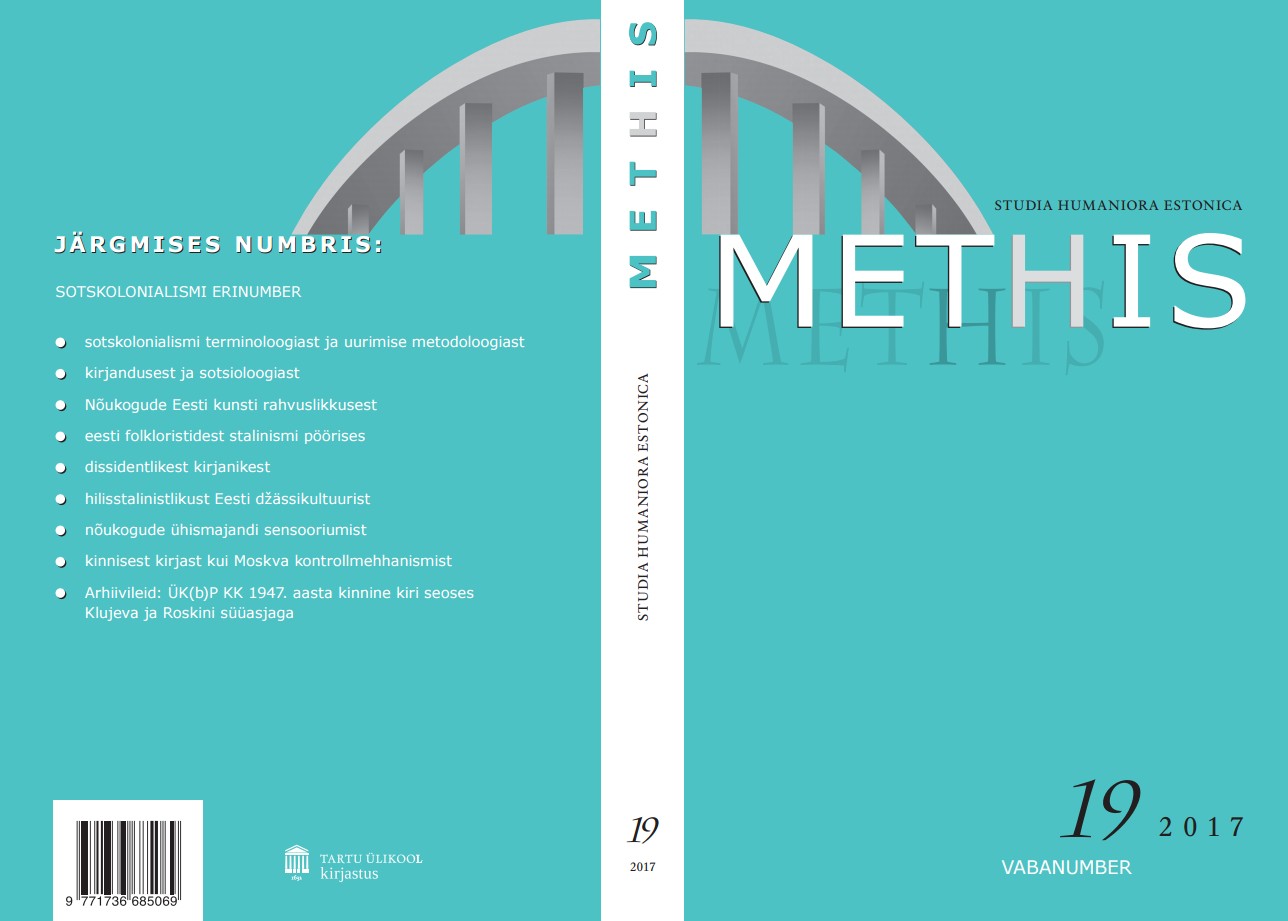Unikaalne ja universaalne nukuteatrikunstis / Unique and universal in the art of puppetry
DOI:
https://doi.org/10.7592/methis.v15i19.13437Keywords:
nukuteater, aineline kultuur, sisu ja vorm, kunstifilosoofia, semantika, terminid, puppet theatre, material culture, content and form, art philosophy, semantics, terms (words)Abstract
Nukuteatri kunstilise eripära käsitlemine pakub unikaalse platvormi kunstide analüüsimiseks. Arutelus tuuakse välja eel-lõpetatud ja esituses muutuvate kunstivormide eristus, käsitletakse kunstinähtusi esemelisuse kaudu, selgitatakse kunstilise kehalisuse mõistet ning nähtava ja nähtamatu käsitlemist kunstilises kontekstis. Nukuteatrikunsti universaalsuse võti peitub ratsionalistlikust maailmakäsitlusest tuleneva nüüdisaegse esemepõhisuse ja nukuteatrikunsti reeglitest tuleneva esemepõhisuse suhestamises. Sellest tulenevalt saab nukuteatrikunsti vaadelda kui universaalset kultuuritõlke mehhanismi ning unikaalset meediumit vaimse ja materiaalse maailma kokkupuutepunktide uurimiseks.
The article is aimed at describing the possibilities of puppetry art in our cultural context. On the one hand, the article deals with puppetry art as a unique means for analyzing crossing points of the spiritual means and the material world. The uniqueness of puppetry art lies in the object-indulgence that offers a unique method for explaining invisible entities. Puppetry is a unique art form for analyzing mind and body questions because the object is the main means of expression and not simply an aid like it is in drama art. On the other hand, puppetry art represents a mechanism of cultural translation that can be disserted as a language phenomenon of the material world. The key of universality of the puppetry art lies in the relationship of contemporary object indulgence and object indulgence according to the rules of puppet thinking. The object connects eternal mythological time-and space to the contemporary materialistic world perception. Uniqueness of puppetry art – using objects as the main means of expression – assures the universality of the art form through the object as an interdisciplinary medium.
Art phenomena can be analyzed on a different basis. At first, I highlight the differentia of the so-called pre-finished art forms and the art forms that change during the exposition. For instance if in architecture, in fine arts and in literature the artist finishes the artwork at a certain stage, then in histrionical art forms the creating process continues until there will be artists who act it out. Secondly, we can highlight the art forms originating from different rules of the genre. The third possibility for analyzing art gives us the analysis of object thingfulness. Music and drama art are different from other art forms that use objects with the meaning that the act of art is born under the eyes of spectators. Even if it is recorded, it is still born from the direct contact with performers.
Disserting the topic of puppetry, I begin with explaining the terms 'doll art', 'puppetry art' and 'puppet thinking'. As puppetry flows from objects, its object indulgence relates to corporality. There are two aspects in corporality in art issues: one of them involves the person as a creator and perceiver with senses and the other type of corporal depicts artwork as a material. All kinds of physical entity can turn corporal on the theatre stage. It follows that noncorporal physical entities can turn to visible objects in the theatre art context and there can be objects without real physical materiality in the art context. I handle physical and artifical corporality as physically experienced forms of empirical materials.
The depth of mind has been the object of interest throughout centuries in different religious, psychological and theoretical explanations. As the hearable and visible (i.e. measurable) parameters cannot assure the quality of art expression, people should have a kind of sense that can perceive and evaluate the art experience substantially. We can evaluate the quality of art with our content-sense that has any universaly measurable parameters.
Puppetry uses a kind of special language, which consists of meaningful symbols. This system of independent rules can be called puppet thinking, puppet philosophy or puppetrism. Puppetrism is considered to be the way of seeing or showing objects where the objects are active through animating them. According to puppet-thinking principles, ideas and thoughts can be taken as realistic as objects. Personification of everything and every phenomenon in puppetry is an example of metaphorical thinking.
Puppetry art is a universal mechanism for the act of cultural translation. Puppetry art can be disserted as a language phenomenon of the material world. Talking about the function of puppetry within the whole cultural system, one can say that puppetry serves in several purposes as a connecting link because as a symbolic genre it uses methaphorical thinking, puppetry commingles routine life and art life using objects to express a thought. As an object is the most important differentiating issue in puppetry, it highlights puppetry from all other performing art forms. Conclusively, we can say that puppetry art entails three interesting branches in our cultural system that can be objects of closer study in the future:
1. The puppetry art aesthetics as the explanation of mind and body topics is the homogenous structure of art.
2. Puppetry as the “laboratory” of material culture studies.
3. Puppet thinking is a discursive methodological platform for discussing the topics of philosophy of mind.
Hence, puppetry has to fulfill a special role in contemporary rational world perception. There are a lot of unused possibilities in our cultural context for puppetry art that is able to cross borders of different subject fields.


